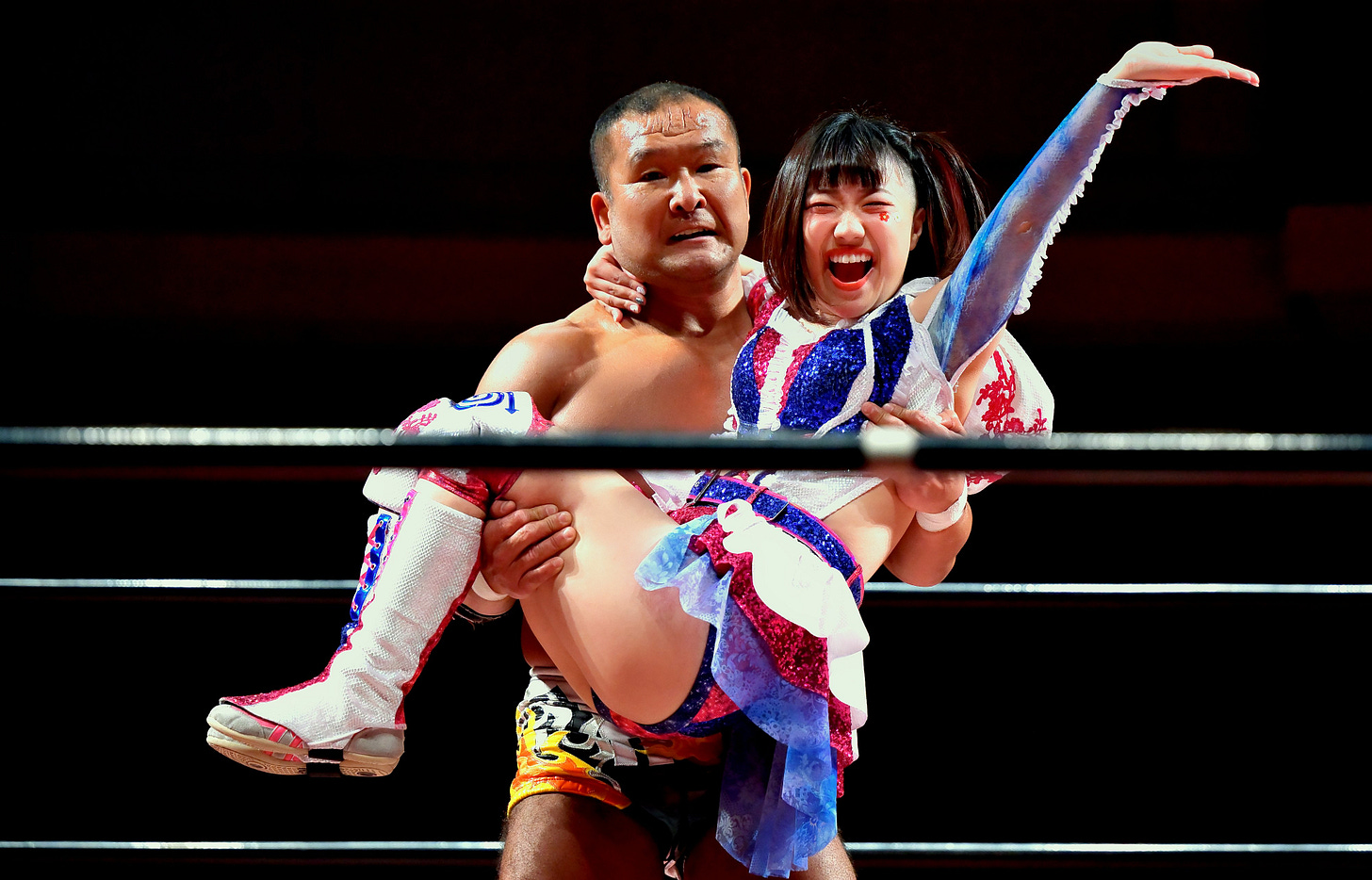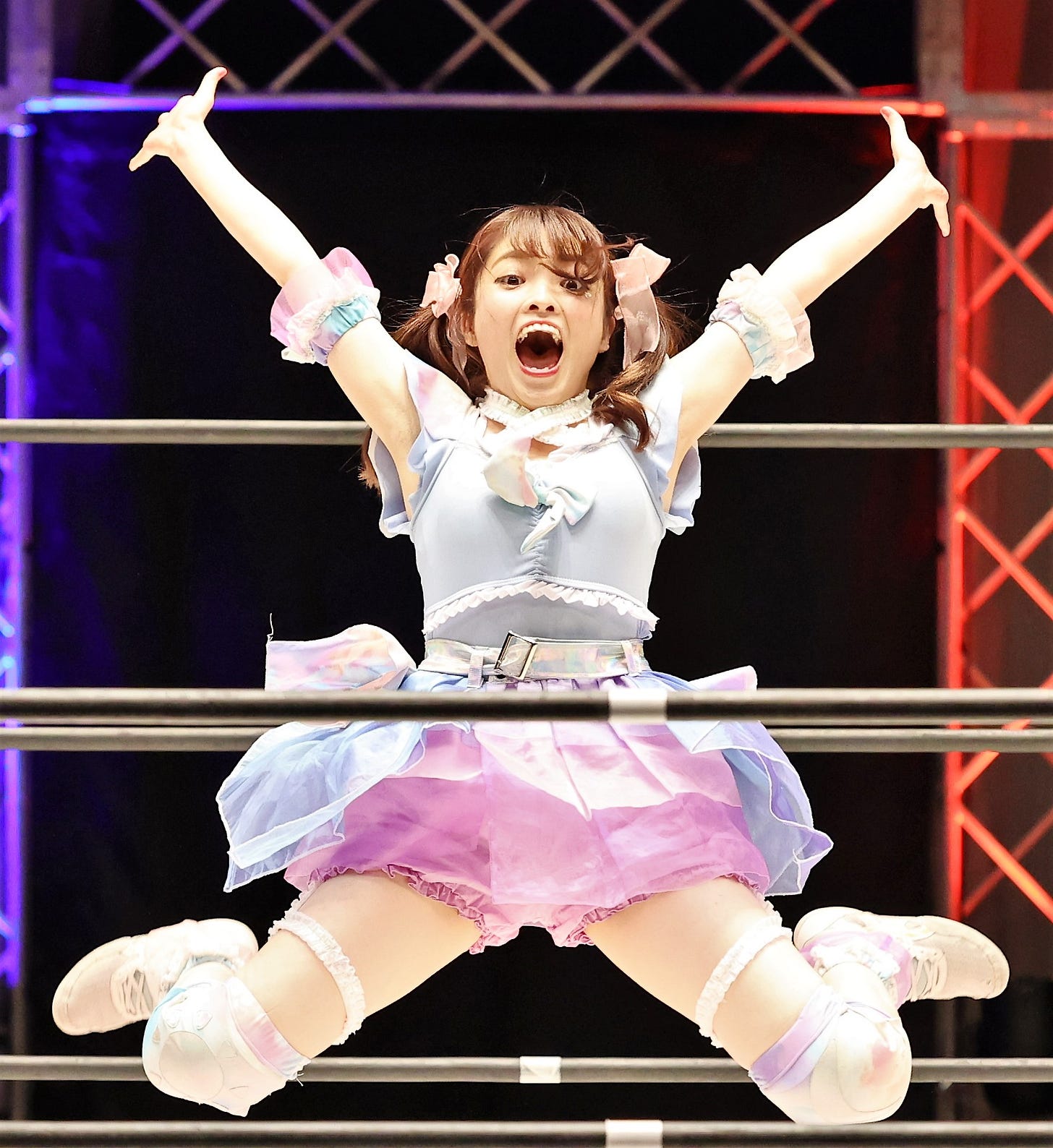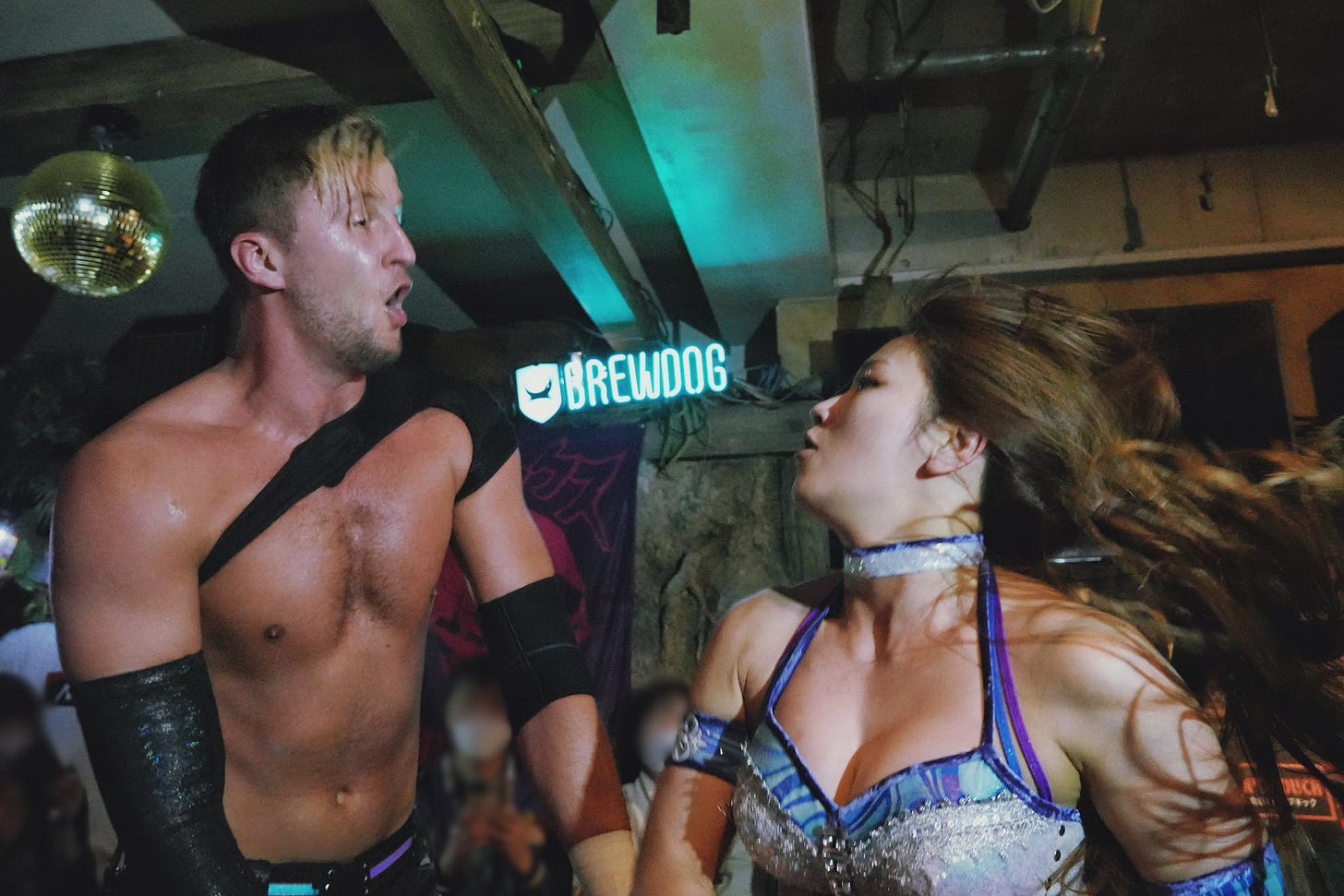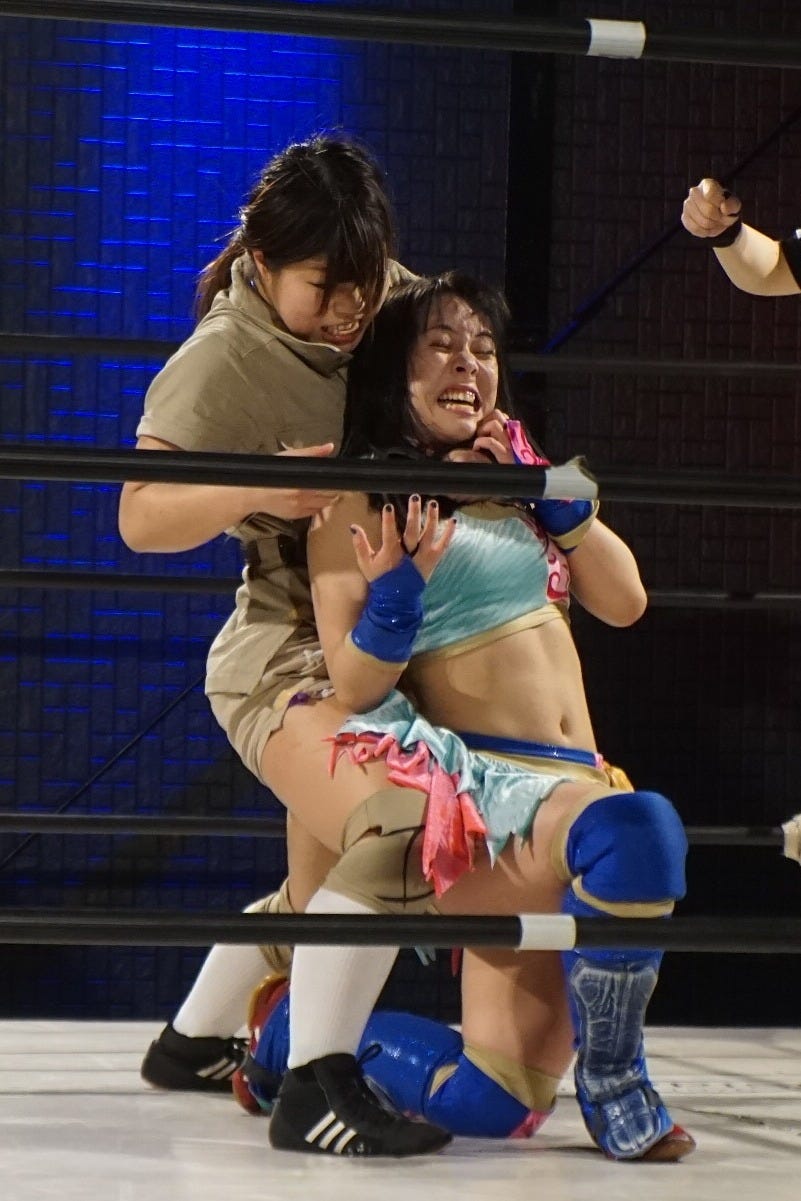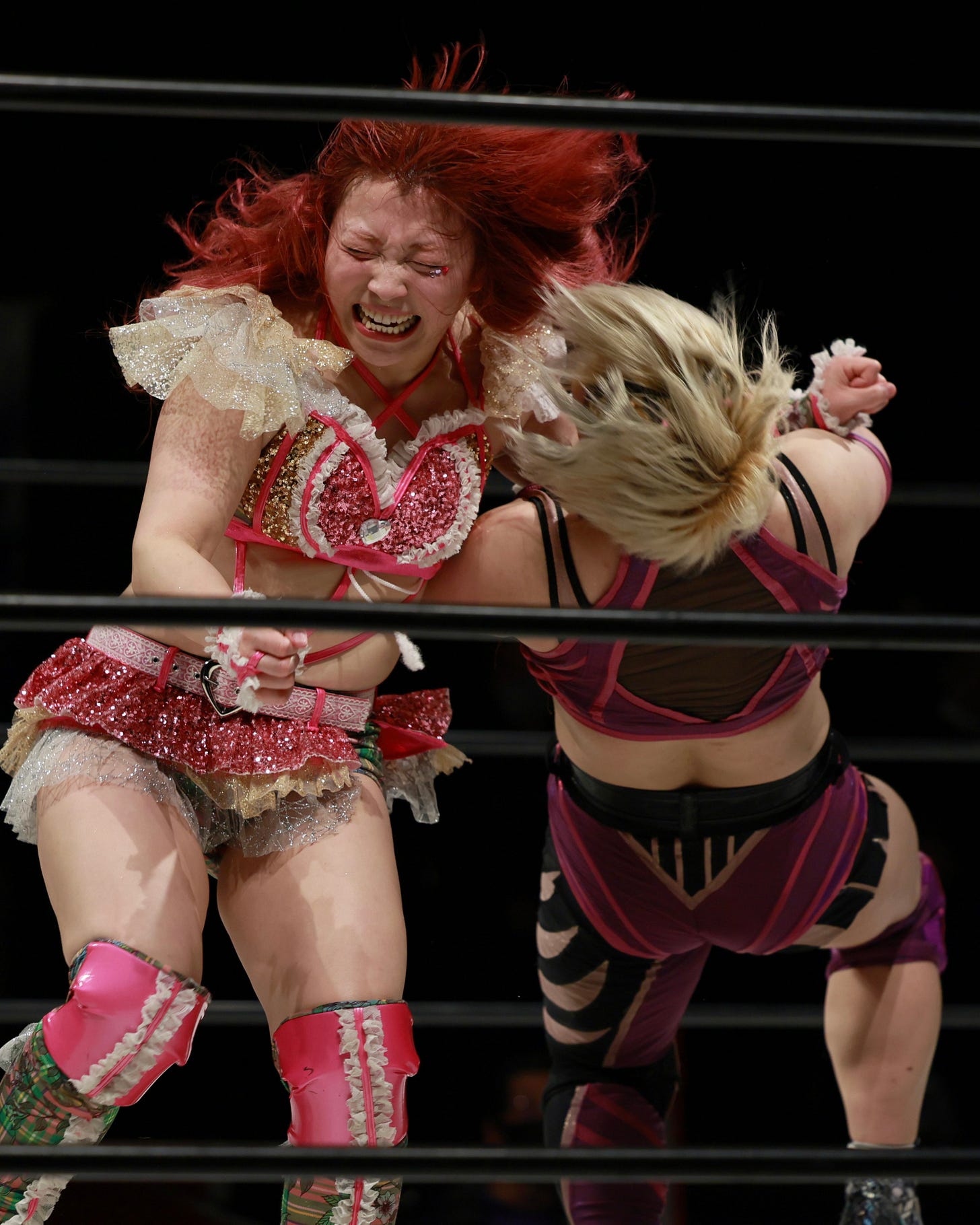Flupke's Month in Wrestling: March 2023
ActWres girl'Z - Baka Gaijin & Friends - Ice Ribbon - SEAdLINNNG - Tokyo Joshi Pro - Zero1
Front Matter
Each image used in this newsletter is linked to the Twitter account responsible for it: simply click through to bring up the original post. If you are a photographer whose image I have used here, and you do not grant me permission to reproduce your work, please let me know (Twitter: @FlupkeDiFlupke) and I will remove it. Thanks!
写真家さん、ここにイメージが写すことが許可しなければ聞いて下さって私は大至急除きます (ツイターの @FlupkeDiFlupke です)。ありがとうございます!
The Michelin Guide Star System
One star - Very good
cookingpro wrestling in its category.Two stars - Excellent
cookingpro wrestling, worth a detour.Three stars - Exceptional
cuisinepro wrestling, worthy of a special journey.
Subscribe now!
Subscribe to Marshmallow Bomb for free to receive all our posts direct to your inbox, or donate $5 a month to access the full archive. A portion of every subscription supports Amazon Frontlines, an organisation dedicated to working with Indigenous peoples to defend their way of life, the Amazon rainforest, and our climate future.
ActWres girl’Z
Miku Aono vs. Natsumi Sumikawa
23.02 / Yokohama Radiant Hall
I’m not going to get into pulling apart STARDOM main event style for a second month running. Just know that it happened again - I tuned in for a hyped title match and came away annoyed and confused. Confused by the lack of clarity in the storytelling, and annoyed by the over-abundance, four matches from the top: why do you need this five minute coda of super-finishers and near-falls when the story of the champion’s last-ditch comeback has already been perfectly well told?
This here was a match that knew exactly what story it was telling, and which didn’t step an inch beyond the over-kill line in getting that story across. It’s established early on that Aono has the clear advantage when it comes to both power and striking ability, but can’t cope with Natsumi’s submission nous, or her speed and agility on the counter. Abut eight minutes in there’s an apparent turning point: Sumikawa gathers up all her power and drops Aono with a Powerbomb that rightfully has her out for the count. But Natsumi drops too - lifting a relatively tall, well-built rival’s entire body-weight above your shoulders on legs that have already been kicked to shit is a risky strategy when all’s said and done - and can’t capitalise as urgently as she needs to. She hits a Somato and Aono’s power comes back in an instinctive last-gasp flash as she pulls herself off the mat to reverse Sumikawa’s pin. When Aono does get another window of opportunity shortly after this near-escape, it’s her speed and agility, as well as her focused, economical thinking, that seals the victory: she neatly turns a backslide into a short-arm lariat, following this up immediately with a pin attempt, and then quickly hitting a back suplex when that combination isn’t quite enough. The characteristics of the two fighters are established at the outset, and we get one fake-out twist before the real one. Boom.
Aono and Sumikawa are (I hope) being set up as guiding lights of the new ActWres girl’Z; Ace and primary antagonist, maybe. This could easily have been the final of this singles title tournament, and it could easily have been the main event of this show. As it happened, it was neither, so they went eleven minutes, and held back on the drama and high spots, so as not to tread on the toes of the two younger wrestlers that were set to go on after them: Misa Matsui and Kouki’s fiery, gruelling main event was an indication of how far they might go in this company, made all the more delicious and digestible for having not been eclipsed by the match that came before it.
Aono and Sumikawa will have bigger, more elaborate matches than this one, possibly sooner rather than later. Aono did have a bigger, more elaborate match in the tournament final, against Kouki, and it kicked ass, obviously, but it also followed a more routine and predictable Big Match structure. I’m always drawn to matches that know exactly what they are, and that only throw in as much as is necessary to tell the story at hand: it could just be that this quality is found more easily in matches that don’t take place on the biggest stage. But small, precise matches like this one can be vitally important in helping to layer the stakes for future main event epics. I only hope those eventual bigger matches are as smart as this one, that Aono and Sumikawa don’t lose the thread of what makes them distinct as performers, and of why they’re doing what they’re doing, even as the near-falls rack up and the super-finishers get dusted off. If AWG can keep getting things as right as they got it here, we could have a genuine rival to TJPW on our hands.
Michelin Guide Star Rating: ☆
Asako Mia, Kanamic, Haruka Ishikawa & Chii Aoba vs. Cat MASK Calico, Rensan, Yufa & Koara Fujimoto
12.03 / Korakuen Hall
There’s very little new under the sun: that’s a rule for life in general, but it’s especially true in wrestling, and doubly so in Japanese women’s wrestling, where the pioneers of the 80s and 90s were effectively half a century ahead of their time. There’s the occasional moment of marked innovation - Mizuki’s Whirling Candy, Mei Suruga’s entire career - but for the most part we’re content to watch the same shapes being made and the same poses being struck, over and over again, more or less convincingly.
It’s always fun when wrestling brings something unexpected in from the outside world, though. Out of the brain fog of the 2020 lockdowns, one wrestling show that really stands out to me is the empty-arena one-day tournament TJPW ran in March of that year, because the prize that day was a bunch of vouchers for a Mongolian BBQ restaurant. DDT have been good value for this sort of thing over the years, too. Here’s Dramatic DDT’s summary of one of the first things ever to catch my eye on that blog, a storyline from November 2016:
The last time Danshoku Dino wrestled in Saku he successfully transformed the area into a Gay Town. This time he wanted to rename the chanko-nabe recipe created by Toru Owashi’s family into something too lewd for me to understand. Kouki Iwasaki objected to this and vowed to protect the restaurant from Dino. Unfortunately for Iwasaki he got his face smushed into Dino’s backside and was then pinned by Keisuke Ishii. Dino proudly called out the recipe’s new lewd name after the match.
Admittedly, WWE regularly relies on extra-curricular storyline beats to build to their big matches, but the elements are usually fairly limited and predictable. In 2016 I was still only just in the process of moving from mainstream North American wrestling to the Japanese indies, and “fighting for the right to give a family hotpot recipe a lewd name” struck me as the most fantastical motivation for a wrestling match I’d ever come across in my life.
And so to this match. I won’t say that “trying to cadge free accomodation in a 4-star hotel in Nara when AWG visit the city in August” is the motivation here, because these two teams were booked to fight anyway, and the Nara Piazza Hotel pretty clearly hasn’t agreed to anything, besides maybe emailing Asako Mia a high-res copy of their video brochure to use for her entrance. But even framing the match around a silly little one-and-done storyline like this tickles me in places most “normal” matches can’t reach.
Their opposition are a riot of colour and fun, and this is a relatively zippy eight-minute contest, even if Haruka Ishikawa looks a little less assured as the “serious wrestling” load-bearer than she has in previous appearances. But what really makes this is the fact that, before their entrance, Asako, Chii and Kanamic deliver a pre-recorded dialogue which reveals some significant behind-the-scenes tidbits about life as a rookie wrestler - AWG don’t pay for everyone’s overnight accomodation on trips outside Tokyo, we learn, meaning that the cost of travel can be a hurdle for performers that are just starting out - before offering one particular hotel prime advertising space during their match in the hopes they’ll receive free bed and board in return.
That’s it. We’re not talking the heights of absurdism here - this isn’t Tsukasa Fujimoto fighting her Giant Panda lover’s wife - but it’s still enough to induce me to spend longer on thinking and writing about this match than probably anyone else in the world. It’s subversive in the same way that “wrestling for BBQ vouchers” is subversive. Wrestling tends to exist in its own sealed-off univerise, and has its own, fairly unique version of truth. Sponsors can be (and presumably insist on being) a visible part of the pro wrestling spectacle, but for three performers to (literally) go into business for themselves because they’re too poor to afford overnight accomodation whenever their employer goes on tour feels beyond the pale. It’s sly humour, not a serious critique, but it’s breaking enough rules to make me sit up and take notice. Asako Mia in general feels like she could be a good source of gently subversive playfulness going forward: may she be a shibboleth standing between wrestling fans with a sense of humour and wrestling fans with spreadsheets for many years to come.
Baka Gaijin & Friends
Lingerie Mutoh vs Inoue
07.03 / ARENA Shimokitazawa
I don't know whether this was all dangerously real or whether, as tends to have been the way of things throughout wrestling history, it was actually a pre-meditated job, and Inoue was an audience plant. And I don't want to know. All that matters is that infinite galaxy brain Munenori Sawa pulled off a thoroughly convincing spectacle here of flying about as close to the sun as the art of pro wrestling allows.
Lingerie Mutoh (AKA Munenori Sawa) is booked to do “some sort of performance” on Chris Brookes and Drew Parker’s third self-produced mat wrestling show in a venue that Google Maps lists as a “Japanese curry restaurant”. He comes out and issues an open challenge to the audience, which includes former IWGP Heavyweight Champion Will Ospreay, but referee Kiso is keen to play it safe and won't allow Mutoh to wrestle anyone with a contract. So Mutoh settles for the next best thing, pulling in a random member of the audience and coaxing her through what to all intents and purposes is a pro wrestling match.
Obviously, you shouldn't watch this expecting high marks for verisimilitude or technical acumen, although the power of Sawa's selling to turn the inexpert fumbles of a (presumed) complete amateur into something that can pop a savvy crowd deserves praise on this front. But where this fails as a conventional match, it succeeds as a balls-to-the-wall social-theatrical experiment. It's the sheer audacity of the thing that matters here.
Ostensibly, what we're seeing is Sawa pulling off one of those matches where a wrestler fights an inanimate object, only with an even greater degree of difficulty. What separates a human being from a broom, at least in this context, is that human beings are fundamentally unpredictable, and Sawa embraces that chaos here, clearly massively enjoying himself whenever Inoue takes the initiative and goes into business for herself.
The crowd is thoroughly into it too - they explode when Inoue slaps Sawa on the back, a move you sense he hadn't necessarily seen coming. It's a pop of acute tension and release - Sawa might be confident he knows where this is all ultimately heading, but the crowd don't. They can't be sure what kind of ride this is that they're on, and it gives an edge to the whole performance that you almost never see in wrestling, at least not outside the experimental fringes where Sawa has made his home.
You can't help thinking about Inoue herself. Where did those slaps come from? What part of herself did she have to dig into in order to go along with what Sawa wanted her to do? Was this empowering, terrifying, or just amusing for her? What might have happened had Sawa chosen somebody different? I don't often come away from a wrestling show asking myself questions like this, which is a sign that Brookes, Parker et al. are using their unconventional set-up to good effect.
Michelin Guide Star Rating: ☆
Chris Brookes vs. Maya Yukihi
07.03 / ARENA Shimokitazawa
“This venue! And this match!”, yells Baliyan Akki on commentary after Brookes has just sent Yukihi flying into the audience with a John Woo dropkick, “[do] not suit each other!” He's right in a technical sense: Brookes legitimately broke the chandelier above the bar in another high spot, which was something he was always teasing at the Frog & Bucket but never delivered. In another sense, though, this venue and this match couldn’t be better suited.
This was a match built around high spots and strike exchanges and not a lot else - the finish is Brookes taking a Tiger Driver from Yukihi and then popping up and hitting a Praying Mantis Bomb of his own. But where that might have felt unsatisfying in a larger venue, in this setting it felt almost as much of a wild experiment as the Lingerie Mutoh match it followed on the card. Pulling off difficult moves in a cramped space takes a high degree of technical finesse, and the results looked devastasting - Yukihi's diving Blockbuster from the bar was a particular highlight. And at such close quarters, the strikes had to look doubly authentic in order to propel the match along, a requirement which both Yukihi and Brookes were happy to oblige.
Venues like this don't tend to be used for stadium epics; put this match in a setting that's more suitable for big bombs and super-finishers and I'm not sure how well it stands up. But in front of a crowd that was so close to the action that being taken out by a stray flailing limb was always a very real and present danger, in a room where there’s nowhere for sloppy work to hide, this was a real thrill, and a clever (and also dumb) recontextualisation of the main event style that Yukihi excelled at during her time at the top in Ice Ribbon.
Ice Ribbon
Harenochi Hareruya (Asahi & Chie Ozora) vs. Nao Ishikawa & YuuRI
04.03 / Warabi Wrestle Butokan
On the 11th of March, I signed up for the Club Ice Ribbon service on YouTube, learning that they were broadcasting weekly shows from the dojo. I watched the first one that popped up, had a whale of a time, and then wrote this: “I thought Ice Ribbon was dead, but it turns out I just wasn't looking in the right places.” I wrote that “this was a match whose overall vibes convinced me that these dojo shows are keeping the flame of P’s Party alive - it’s not a question of possibility, it’s that all the stuff I love about Ice Ribbon is still happening.” I praised Asahi as “the heir to Tsukushi’s smiling contempt”, but reserved my biggest praise for Nao Ishikawa’s new ‘explorer’ gimmick, which had seemingly come out of nowhere and which seemed to me to “[tell] you everything you need to know about a company whose identity is built around not taking things too seriously.”
I was delighted to have found a reliable source of low-stakes, high-energy wrestling that I could use to warm myself up with on cold Thursday nights. I watched several more of Explorer Ishikawa’s matches and found that after years of being fairly lukewarm in my praise for her, she was suddenly becoming one of those must-see, no-skip wrestlers. I wrote that I was excited for the upcoming Korakuen show and looking forward to making a regular habit of those Saturday morning dojo uploads. And then a week later Ishikawa and Asahi left, both claiming that Ice Ribbon’s management had killed their love for wrestling.
It’s not about me, just as it wasn’t about me when Suzu and Sera left, or when Mashiro and Tsukushi retired, or when Maya Yukihi went freelance. Asahi will work for ActWres girl’Z for the next three-to-six months and I have no doubt she will thrive there. Ishikawa will take a break from wrestling but hasn’t written off the prospect of returning - I could see her joining up with the NOMADS crew if she does; I also think she’d be right at home in (and deserves an opportunity in a promotion run as well as) TJPW. But still - I’m furious about this one. Furious in a way I can’t recall ever having been as a wrestling fan before.
What’s obvious in retrospect is that the departures are all part of a continuum, probably stretching back as far as Giulia’s exit in 2019. In the light of Ishikawa’s boldly direct comments criticising President Sato, it’s not possible any longer to ignore that this is a story of chronic mismanagement. But as someone who just started enthusiastically giving money to the promotion again, it’s hard not to look at it like this: you’d lost all that talent, all those stars that came from your dojo and are now making waves across the wider world of joshi, and, even though it seemed like there was very little left, you were still able to run great wrestling shows, little bursts of joy that were no less vital for taking place in such small rooms in front of such a small audience, in no small measure because of the joyful presence of Ishikawa and Asahi. And now you’ve chased them away too.
Tucking into that first Club Ice Ribbon show, it struck me that it’s almost harder for stars like Asahi and Ishikawa to not produce entertaining wrestling in an atmosphere as free and easy as an Ice Ribbon dojo show, but the company’s management has seemed ruthlessly committed to sabotaging this winning formula for the past three years now. It seems almost criminal to force Asahi, a wrestler whose facial expressions alone are so compelling that I often find myself rewinding to watch them again, into not wanting to wrestle for your organisation. Yappy concluded her revealing, emotive Twitch stream in the immediate aftermath of the departures by saying that she was going to stay and fight for a better Ice Ribbon. I would love for her to succeed, but I can’t promise I'll be there for every step of the journey, and a big part of me can't help feeling that maybe it is time for Ice Ribbon to die - at least in its current form, so that the unique spirit that all these performers have done such a good job of fostering can be set free, and find somewhere that wants to offer it a good home.
SEAdLINNNG
Rico Kaiju vs. Misa Kagura
20.03 / Shinkiba 1st Ring
One of the things that fans often find when they dip into golden-era joshi for the first time is how real and gritty and loud it all is. We all know the story about Vince McMahon all-but abandoning women’s wrestling for a decade after Aja Kong broke Chaparita Asari’s nose on Monday Night Raw. Gruesome though that episode is, it’s emblematic of a kind of high-intensity realism that joshi wrestling still aspires to in some quarters, SEAdLINNNG included. Nanae Takahashi and Arisa Nakajima are clearly big believers, and so it’s no surprise that some of their feeling for making things look fierce and violent would have passed on down to Rico Kaiju too.
Despite the obvious in-ring improvements she’s been making over the past year though, I would not have expected to be dusting off the old Aja Kong analogy for Misa Kagura. But there she is, this fluffy idol wrestler, wringing more aggression and physical impact out of a wristlock spot than anyone this side of Cyanide Sid Cooper (thanks to George for providing me with that point of comparison). And there she is repeatedly shoulder-barging Beast Kid to the mat - no reciprocal 50/50-ing here, nothing that doesn’t look like would come in handy in a real fight. And there’s Beast Kid fighting back, cutting off Misa’s corner taunts, kicking her legs out from under her with casual cruelty, dropkicking her in the face with the snap and precision of a snooker player sinking the last black in a 147 break. At one point Misa has a Boston Crab applied, and she’s screaming through it, visibly aching and exhausted, but she’s so committed to keeping a hold of it that Rico’s only means of escape is to wriggle aggressively enough to send Misa flying into the ropes.
I haven’t seen too many AJW Junior Championship matches - there’s a 1997 Momoe Nakanishi vs. Emi Motokawa one that’s well worth a watch if it ever gets re-uploaded to YouTube - but what I have seen from that oeuvre has tended to look a lot like this match: lacking the sheen of a perfect polish, but full of life-or-death, blood-and-thunder intensity. AJW wrestlers used to be so good at creating the impression they were fighting for real because, in a way that’s exactly what they were doing - stories that have come out of the promotion in the years since its closure hardly paint a picture of locker-room harmony. Joshi wrestling has, we hope, evolved for the most part past the really grim stuff - the back-stage bullying, the eating from bins - but the surprising levels of ferocity we saw here will never get old as a spectacle, however it is that Kaiju and Kagura’s generation are accessing it.
Michelin Guide Star Rating: ☆
Tokyo Joshi Pro
Shino Suzuki & Raku vs. Miu Watanabe & Hikari Noa
06.03 / Shinjuku FACE
Often, the joy of a rookie debut match is in seeing some small, endearing detail being launched into the world for the first time - see my review of HIMAWARI’s Tokyo Joshi debut, where her conducting of the crowd in different clap rhythms and her weird take on the basic drop-down spot threatened to overshadow most of the rest of the Ittenyon card. Shino Suzuki’s debut definitely wasn’t lacking on that front - even before watching the match I’d already lost my mind on learning that her entrance theme features a bus tour voice-over - but it was surprisingly more besides.
It feels odd to call all-Up Up Girl matches protected, but it’s true. Miu, Hikari and Raku are all firmly established on different levels of the TJPW hierarchy, so having the all in the same ring isn’t quite the same as, say, a singles match between any of the big three, which nowadays would only be run if the Princess of Princess title was involved (I’m not even sure you’d get a Miyu vs Yuka singles match in the Princess Cup at this point). Still, in 2023 it feels like something you save for special occasions, and this was an extra-special occasion, marking the first shake-up to the group since PiPiPiPi Pinano retired a little over four years ago.
It played out like that that too, with Miu and Hikari switching to grumpy veteran mode for arguably the first time in their careers, and with Raku raising her game even above the fine performances we’ve seen from her recently. As opponents, Miu and Hikari were sadistic in giving Shino her first taste of the rigours of the Princess Road; as a partner, Raku did everything she could to give Shino a winning start to her career, gliding around the ring and tying Miu and Hikari up in knots.
Every member of the roster that’s debuted over the past half-decade is technically a junior to Miu, Hikari and Raku, but in a more acute sense Shino is their junior, their prospect to build up and mould. Shino is immediately absolutely adorable, and her in-ring is surprisingly polished even at this very early stage, but beyond that this match was notable for a subtle shifting of gears in the Up Up Girls camp; I keep joking about the moment when TJPW’s new generation will break through and become the Old Guard, but this match offered a genuine glimmer of that eventual reality. Meanwhile, for Shino, the journey has only just begun.
Zero1
Masato Tanaka vs. Momoka Hanazono
21.03 / Osaka Azalea Taisho
Momoka gets splashed through a table in this match, and she still rallies enough to crack the former FMW Double Champion over the head with her bubble wand, get in a couple of near-fall roll-ups, and kick out of at least two of his finishers. People who see Momoka’s comedy antics and see her as denigrating or cheapening pro wrestling somehow have it so, so wrong. Momoka clearly loves pro wrestling, enough to take on a General Manager role in her early twenties, and enough to subject herself to this kind of physical gut-check.
The Momokaisms are all a reflection of that love, too. She’s 100% committed to being who she is in the ring, even at the cost of people overlooking her very real technical ability, and what’s more they’re strategically useful: you can be a war-grizzled 30-year veteran, but how are you going to respond when your opponent just won’t stop runnng around the ring in seemingly random directions? Masato Tanaka gets it. That 2023 Wrestler crown shows no signs of slipping just yet.




